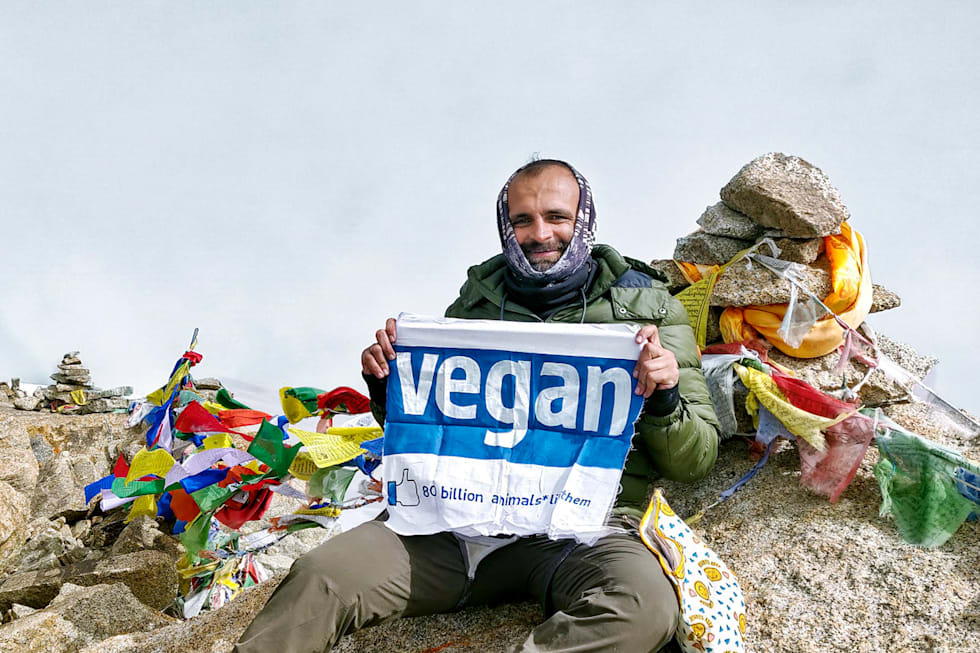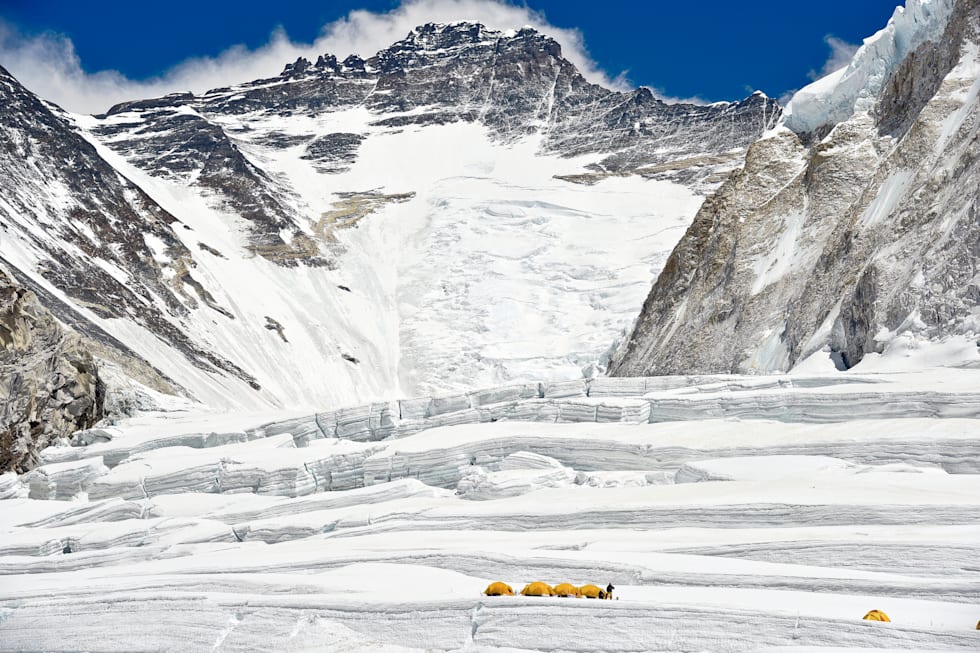vegan mountaineering is not only possible, but according to Indian climber Kuntal Joisher, it leaves a positive legacy for the future of the adventure.Written by Kuntal JoisherPublished on 09.03.2021 · 13:45 UTC+5:45The Red BulletinMy name is Kuntal Joisher. I’m a mountaineer. I’m also a vegan. I was born 41 years ago in Kharagpur, West Bengal, to a Gujarati family, making me a vegetarian by religion, but in 2002 I converted to veganism for ethical reasons. It seemed a natural step, but on entering the world of climbing I realised there were barriers to overcome, not least the misconception that a vegan lacks the muscle-building protein necessary to become an ultra-endurance athlete. Twelve years ago, no one in my family would have believed I’d one day challenge this myth by scaling the world’s highest peak. But then I fell in love with mountaineering by accident.I grew up in Mumbai, where summer temperatures can soar as high as 40°C, so I’m not predisposed to cold-weather sports. And I’m no adrenalin seeker – I worked as a software engineer, and up until my early thirties I avoided physical exercise; I was 40kg overweight before taking up mountaineering.Then, in 2009, my wife and I took a trip to the Shimla hill station in northern India. Though poorly equipped, with just trainers on our feet, we trekked up Hatu Peak. At 3,400m, it wasn’t especially high, but for me the ascent was transformative. Looking across the snow-capped landscape, I found new purpose. From that day on, I spent every spare weekend exploring the Indian Himalayan Region, and my fascination with Everest grew.In October 2010, I took the notoriously dangerous flight to Nepal’s Tenzing-Hillary Airport, 2,845m above sea level, to admire the great mountain at close range from nearby Mt Pumori [the 7,161m-tall peak sometimes called ‘Everest’s daughter’]. As I gazed at Everest, aglow in the setting sun, I knew I had to climb it. But first I had to convince the trek leaders that veganism could support an endeavour usually fuelled by high-fat, high-protein meat and dairy products. If I failed, my diet would be blamed.

In 2011, as a practice run, I climbed the 6,153m-high Stok Kangri in the Indian Himalayas. Not wanting to be seen as someone whose diet might make them less dependable in high-risk situations, I asked for the menu plans in advance and made sure the cooks at base camp could adapt every item with little fuss. You need a lot of food at extreme altitudes. At 5,500m, your body burns through 4,000 calories per day at rest, and above that altitude your appetite diminishes, so most climbers load up on meat and dairy at base camp, where you spend four-to-five weeks acclimatising to the lack of oxygen. For vegans, this means triple portions of oats with powdered soya milk, fried potatoes, vegetable curries, bread and pulses, plus as many fatty cashews and nutrition bars as possible.In 2014, I set out to conquer Everest. I made it to the Nepalese base camp, but the journey was cut short by a colossal avalanche that killed 16 Sherpas. I came back the next year, but there was the terrible earthquake that devastated Nepal. I was at base camp when the avalanche swept through, covering everything in snow and debris. I was lucky to make it out alive.
I knew I had to climb Everest, but first I had to convince trek leaders that veganism could support the endeavour. If I failed, my diet would be blamedKuntal Joisher, vegan climberSuccess came in 2016. And it turns out a plant-based diet is conducive to high-altitude climbing. Most climbers require about four days to ascend from either the Nepalese or Tibetan base camp, and an intake of around 15,000 calories a day. As the nervous system becomes starved of oxygen, it ceases to tell your brain you’re hungry. I’ve repeatedly seen non-vegan climbers struggle to put food in their bodies. But I was eating a lot of carbs and fats, which don’t give you the satiated feeling meat does; consequently it’s easier to eat. At 8,500m, I like comfort foods, which is no bad thing – at that stage it’s not about protein, vitamins or minerals, just calories. I carry Clif Bars, Oreos and meat-free dehydrated meals in my bag, and pitted dates in my pocket – if you leave the stones in, they freeze.When climbing the Hillary Step, there are three snow humps to cross before you see the top. There in the distance, my Sherpa guide, Mingma Tenzi, waved to me. It was so overwhelming, I couldn’t hold back the tears. With a minute’s credit left on my satellite phone, I called home, then I sat down to soak in the view from the top. I’ll never forget those 20 minutes. The only feeling that compares is the birth of my daughter. It was a huge achievement for me as a mountaineer, but it also shone a positive light on veganism.

Even with a population of more than 20 million, no one from Mumbai had ever climbed Everest, so I was given a hero’s welcome. But I found it hard to celebrate as a true vegan. Before the expedition, I’d looked tirelessly for a featherless suit, but animal-free gear that provides high-thermal insulation proved impossible to source, so I completed my 2016 ascent in a cruelty-free feather-down suit. Ultimately, it clashed with my ethical beliefs. I knew I had to go again and I had to find a company willing to make me a vegan suit, but the market was niche.To my surprise, a simple Facebook request was answered by Save the Duck, an Italian sustainable-clothing brand whose products are 100-per-cent animal-free. For me and Mingma, they designed a high-performance vegan suit – an industry first – that would withstand temperatures of -50°C and wind speeds of up to 100kph.
Today, I’m proud to say I’m the first recorded vegan to summit Everest. But what I’d love even more is to normalise vegan mountaineeringKuntal Joisher, vegan climberWe received our suits in April 2018 and decided to test them out on Lhotse [the world’s fourth-highest mountain]. Its peak is just 300m below Everest’s, but it’s a lesser-known mountain, so my thinking was that if I didn’t make it back, at least it wouldn’t make the news headlines. We reached the summit on May 15, 2018 and, if anything, our suits were too warm. When the sun beams off the snow, you get hot in so much padding. I asked Save the Duck to make modifications: zippers at the top, and more inside pockets for carrying essentials, because body heat stops your tech from powering off.This time, I climbed Everest’s North Face from Tibet, which is considered a more technical route because the conditions are harsher. I summited on May 23, 2019, at 5.30am, standing proud in my bright yellow, vegan Save The Duck suit, all my toes and fingers intact, and without so much as sunburn. Today, I’m proud to say I’m the first recorded vegan to summit Everest. But what I’d love even more is to normalise vegan mountaineering. It’s like Sir Edmund Hillary said: “It is not the mountain we conquer, but ourselves.” If I can make a positive, tangible difference in someone’s life, that’s the legacy I want to leave. Everything else is secondary.Follow Kuntal Joisher’s expedition blog at kuntaljoisher.com
